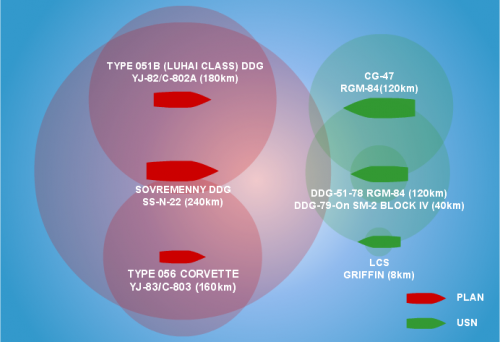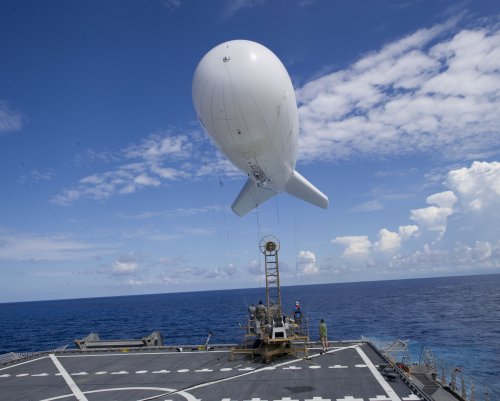"Navy Seeks Rail Guns, Lasers, Cruise Missiles To Improve Pacific Firepower"
By Sydney J. Freedberg Jr. on January 20, 2014 at 9:22 PM
Source:
http://breakingdefense.com/2014/01/navy-seeks-rail-guns-lasers-cruise-missiles-to-improve-pacific-firepower/
By Sydney J. Freedberg Jr. on January 20, 2014 at 9:22 PM
Source:
http://breakingdefense.com/2014/01/navy-seeks-rail-guns-lasers-cruise-missiles-to-improve-pacific-firepower/
CRYSTAL CITY: “I’ve never wanted to enter any tactical scenario where all I had is a defensive capability. It’s a losing proposition,” said the chief of Pacific Command, Adm. Samuel Locklear. “You will defend yourself until you’re dead.”
That was the PACOM commander’s blunt and public response when I asked him about the chronic imbalance between the offensive and defensive capabilities of the Navy’s surface warships: its cruisers, destroyers, frigates, and controversial new Littoral Combat Ships. Other admirals had angsted over the issue at last week’s annual conference of the Surface Navy Association here, but it’s no coincidence the man who’d have to command any war with China was the bluntest.
The Navy’s has a three-step plan to boost firepower:
In the short term, revive the long-range skip-killing capability it lost when it phased out the 600 -mile-range Tomahawk Anti-Ship Missile (TASM) years ago.
In the mid term, free up missile launchers for offensive use by replacing defensive missiles — each of which can be used against incoming enemy aircraft or missiles just once — with lasers that can keep firing as long as the ship’s generators turn.
In the long term, equip ships with electromagnetic rail guns that can launch solid metal slugs at targets over the horizon at seven times the speed of sound.
“With respect to lasers, we’re talking more about defense,” said Rear Adm. Thomas Rowden, director of surface warfare for the Chief of Naval Operations (staff section N96), when I pulled him aside at the conference. “On the offensive side of the house, we have the electromagnetic rail gun.” Both will be able to fire far more times than any set of missile launchers; the laser will, in theory, hit incoming missiles at literally the speed of light; and the rail gun can fire projectiles at the enemy at velocities no missile can match.
“If you’re getting Mach 7,” Rowden told me, “speed is a difficult thing to defend against.”
That said, rail guns will complement long-range missiles, not replace them: While the rail gun shot would be harder to dodge, the missile can go much farther.
“We’ll have to see what kind of range we’re going to get out of the railgun,” Rowden said. So, I asked, would it ever be comparable to a Tomahawk cruise missile? The admiral laughed out loud. “No! I think it’d be Mach 40 or something like that to get the kind of range.” Rail gun tests to date have suggested they could hit targets up to 125 miles away.
All these weapons, of course, are in the near future. The triple-threat solution is still very much a work in progress, with all three prongs of the Navy’s new trident still in development:
The Long-Range Anti-Ship Missile (LRASM), though a derivative of a proven Air Force weapon, is still in testing, with contractor Lockheed Martin putting up $30 million of its own money to bridge a funding gap. “Our lack of urgency on development of the next generation of surface-launched, over-the-horizon cruise missiles is troubling,” Locklear told the conference.
The first prototype defense laser will deploy this summer to the Persian Gulf for tests in real conditions. But this baby-steps ray gun is only strong enough to shoot down relatively slow-moving drones, not supersonic anti-ship missiles. Even future high-powered lasers will remain relatively short-ranged defensive weapons, unable to fire at targets over the horizon and out of line of sight.
Finally, the Navy’s rail gun has managed some dramatic tests on land, but the weapon’s raw power wears out components — especially the barrel — at an impractical rate. Even when (or if) the Navy gets a rail gun it can fit on ships, only three vessels currently in service or on contract can generate enough electricity to fire one, specifically the three DDG-1000 Zumwalt-class destroyers.
Meanwhile potential adversaries have invested in ever more weapons designed to sink our ships, the most recent example being China’s test of a prototype “hypersonic” missile. (Hypersonic means at least five times the speed of sound).
“That particular test doesn’t bother me,” Locklear told the conference. “[But] this isn’t just about China…..A lot of nations are pursuing hypersonics,” he said, and whoever develops it, “it’s going to get sold.”
Even with current technology, US Navy warships are “out-sticked” by their Chinese counterparts: Their anti-ship missiles have longer range (diagram attached), so they can hit us at distances where we can’t hit back.
Modern warfare is about much more than ships (or tanks, or planes) trading shots with their equal and opposite counterparts on the other side, of course. Today’s weapons range from torpedoes to computer viruses, and they can be launched by platforms ranging from airplanes to the NSA headquarters at Fort Meade, Maryland. Even if you specifically want to sink an enemy ship with an anti-ship missile, you don’t need your own ship to do it: You can use submarines, aircraft, or launchers ashore. Most Iranian and Chinese anti-ship missile launchers live on dry land.
That said, surface ships can sail far from their homeland to threaten targets a shore-based weapon cannot reach, and they can carry far more missiles than an aircraft or even a submarine. So sinking enemy ships is something the US Navy still needs to be able to do. The problem is that its main tool to do so, in the absence of a long-range cruise missile, is the disco-vintage Harpoon, a missile that entered service in 1977 and whose maximum range is roughly 75 miles.
“People pooh-pooh that Harpoon weapon system,” Rear Adm. Rowden told me. “I think that is a gross underestimation of that weapon.” That said, he went on, the Navy’s working hard “to ensure that we have those long range missiles [to fight for] sea control.”
The Harpoon can be fired from either the Navy’s mainstay F-18 fighter-bombers or from shipboard launchers, but the Navy has removed Harpoon systems from its frigates and never even installed them on its newer destroyers. In fact, the mainstay of the surface navy, the DDG-51 Arleigh Burke, was designed from the beginning not to attack the enemy but to defend the rest of the fleet, especially the aircraft carriers, with a radar and missile system called “Aegis,” after the goddess Athena’s shield. In recent years, Aegis has taken on a new defensive role in ballistic missile defense of cities and bases ashore.
That’s all useful, even essential, but we can no longer assume that no other navy will challenge us with its ships. “We need to think about what is surface warfare’s role in other than defensive operations,” Locklear said, “[and] pay more particular attention to the ability to show up on the scene and be lethal and be dominant.”
“This has been an issue for my entire career,” said Vice Adm. Thomas Copeman, commander of naval surface forces, speaking at the same conference. “We need to improve the offensive lethality of the entire surface force,” he said, “[and] free up more space in the missile launchers for offensive weapons.”


